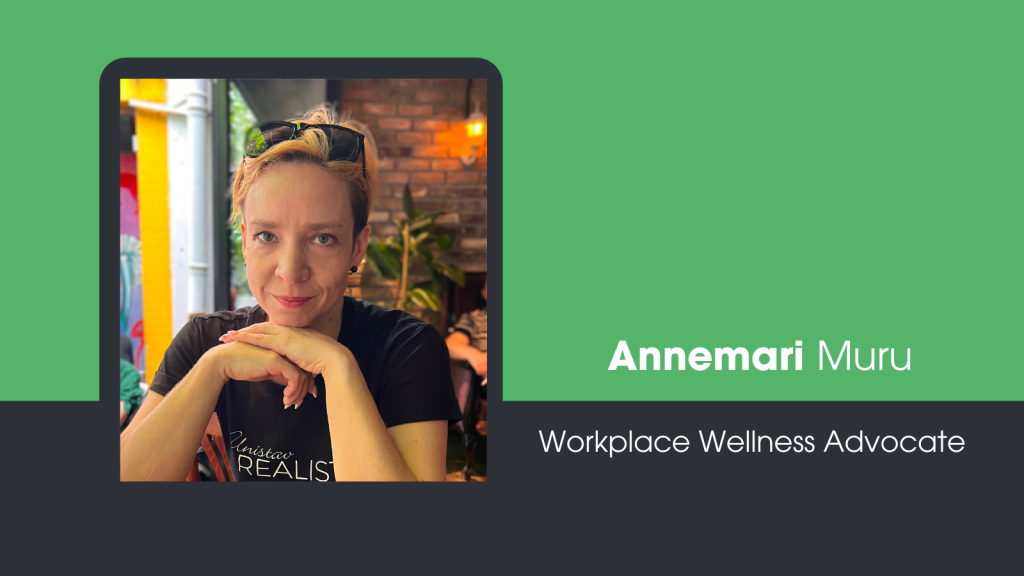Annemari Muru is a dedicated advocate for workplace wellness with a mission to create environments where balance and wellbeing are at the core of success. With over two decades of experience in organisational development and leading teams, she believes that the core of a genuinely fulfilling life and productivity comes from aligning mental and physical wellbeing with our professional ambition. Annemari’s approach, which strongly emphasises the importance of consistent self-care and positive work relationships, enables individuals to become the best versions of themselves. Her strategies aim to foster thriving teams where success is sustainable, and life is fulfilling.

The Social Digest: Can you tell us about your journey so far, and how your extensive experience in managerial roles has shaped your views on workplace wellness?
My journey has spanned over two decades, during which I’ve held various leadership roles that have deeply influenced my perspective on workplace wellness. The way I see it, people don’t have separate lives: work life and personal life—they just have lives, and one aspect inevitably influences the other. Early on, I noticed that teams thrive when their well-being is prioritized, leading to higher productivity and innovation. My experience in organizational development and change management has shown me that mental health plays a critical role in both team dynamics and overall company success. Over the years, I’ve learned that a supportive, balanced work environment is not just a nice-to-have but a fundamental necessity for sustainable growth. This realization has driven me to advocate for wellness practices that integrate mental health into the core of organizational strategies. By focusing on creating environments where individuals can flourish holistically, I’ve been able to guide teams to achieve their goals in a way that fosters long-term success and a healthier, more positive attitude both at work and beyond.
The Social Digest: You advocate for balancing productivity with mental health in the workplace. What inspired you to focus on this aspect of organisational development?
My inspiration to focus on balancing productivity with mental health comes from observing the often-overlooked human side of business. In fast-paced environments, getting caught up in the hustle and overlooking its toll on our mental wellbeing is easy. I have experienced burnout myself. Despite being aware of how it may affect me and my family, saying that I should slow down, it is tough not to put 150% out daily. The difficulty of slowing down in a fast-paced environment is a challenge many can recognise. You are on the go, with all the excitement, adrenaline, and encouraging people around you. I’ve seen brilliant minds dim because they were burning the candle at both ends, and it struck me—what’s the point of success if it comes at the cost of our health? That realisation and my personal experiences have fuelled my passion for advocating a more balanced approach. It’s not just about getting the job done; it’s about doing it in a way that leaves us feeling good at the end of the day. When we prioritise mental health, I believe we unlock a level of productivity and creativity that’s sustainable in the long run. It’s like running a marathon—you need to choose the right pace to last. Just as it’s impossible to sprint through all 42 kilometres in the workplace, maintaining a sustainable pace is essential.
The Social Digest: In your opinion, what are the key elements of a healthy and productive work environment?
A healthy and productive work environment is built on several key elements. First, there must be a culture of trust and open communication, where everyone in the team feels safe to express their ideas and concerns. This fosters a sense of belonging and engagement. Second, mental health must be prioritized through regular wellness initiatives, such as mindfulness practices, flexible work arrangements, and access to mental health resources. Third, there needs to be a focus on work-life balance, ensuring that people have the time and space to recharge outside of work. Additionally, a supportive leadership team that models these values is crucial, as it sets the tone for the entire organization. Finally, inclusivity and diversity should be embraced, as various perspectives have proven to foster innovative solutions and a stronger, more cohesive team. When these elements are in sync, you get an environment where people are not just productive—they’re happy, engaged, and eager to contribute their best.
The Social Digest: Could you share some examples of strategies you’ve used to transform toxic work environments into harmonious and productive spaces?
Transforming a toxic work environment is like turning around a ship—it requires a steady hand and a clear vision. One strategy I’ve used is introducing regular wellness check-ins, focusing on mental health and well-being rather than just performance metrics. This simple shift in focus can do wonders for team morale. Another approach is fostering open communication. You build a culture of trust by creating safe spaces where people can voice their concerns and ideas without fear of judgment. I also emphasize the importance of recognizing and rewarding positive behaviour. It’s not just about turning the tide, but also about making each team member feel valued and appreciated. Lastly, I’ve found that reestablishing clear boundaries and expectations can help realign everyone’s efforts toward a common goal, making the workplace a more harmonious and productive space. It’s about taking small, consistent steps that add to big changes.
The Social Digest: You’ve mentioned the importance of addressing team dynamics and career development. How do you approach these areas to promote well-being and growth within an organization?
As sports were already mentioned earlier, I would say that addressing team dynamics and career development is like coaching a sports team—each athlete has unique strengths and needs that must be nurtured individually, but the goal is for the entire team to perform at its best together. I start by getting to know each team member—their strengths, their goals, and what makes them tick. Then, I continue with assessing the current team dynamics, identifying strengths, and areas for improvement. This often involves facilitating open discussions where team members can share their perspectives and experiences. To promote career development, I advocate for creating personalized growth plans that align individual aspirations with organizational goals. This includes offering opportunities for continuous learning, mentorship, and skill development. I also emphasize the importance of creating a supportive environment where team members feel encouraged to take on new challenges and roles. By focusing on both personal and professional growth, I help teams build stronger relationships and a deeper sense of purpose, which in turn enhances overall well-being and productivity.
The Social Digest: How do you adapt your strategies to accommodate diverse team dynamics and evolving career paths in today’s rapidly changing work environment?
In today’s fast-paced world, adapting strategies to accommodate diverse team dynamics involves using practical tools that foster understanding and collaboration. For example, I often start with a Team Canvas exercise, which helps to clarify roles, values, and goals within the team. This exercise creates a shared foundation that respects individual differences while aligning everyone toward a common purpose. Regarding career development, I recognize that paths are no longer linear, so I advocate for flexible development plans that can evolve as the individual grows. I am a fan of Patrick Lencione’s concepts, such as The Ideal Team Player or The Five Dysfunctions of a Team, which come with practical tools for teams and individual self-assessment. It is a matter of taste which model or concept to use as a frame. Those examples are just few I like and there are definitely a lot more to choose from. What’s crucial is that regular open discussions play a significant role in allowing team members to express their needs and perspectives, fostering a sense of belonging and respect, and ensuring everyone feels heard and valued.
The Social Digest: On a personal level, what practices do you follow to maintain your own well-being while leading a fast-growing company?
It is a tricky question because over the last year, I had to, or as I rather like to put it, “I chose to” make a shift in my practices, and it is fair to say that I finally started to act how I have preached. I usually start my day with mindfulness practices, like a short breathing exercise and stretching, to centre myself before the day’s demands take over. I avoid peeking my phone before I get out of bed, which is one of my bad habits. I also prioritize physical activity, whether a proper workout in the evening or just a short walk during breaks, to keep my energy levels up. Another essential practice is setting clear boundaries—I make sure to disconnect from work at the end of the day and spend quality time with family and friends. I also believe in the power of routine, which gives me a sense of control and organization. So, I schedule regular wellness check-ins, much like a business meeting, to reflect on my mental and emotional state. By taking these steps, I ensure that I’m leading my team or business effectively and taking care of myself to bring my best to the table every day.
The Social Digest: Can you share some insights on how a focus on workspace wellness can directly impact an organization’s performance and profitability? How can companies and leaders connect with you to learn more about transforming their workplaces into thriving, harmonious environments?
Focusing on workspace wellness is like laying the groundwork for a building—everything else stands firmer. Today’s workforce, especially the growing Gen Z demographic, doesn’t align with the traditional 9-to-5 model. They seek flexibility, wanting to work when their energy is at its peak, which often doesn’t fall within standard hours. In intellectual roles that demand high mental presence, this flexibility is critical. It’s crucial for companies to adapt to these changing needs. Prioritizing wellness and adapting to individual rhythms boosts productivity and creativity and attracts top talent, reducing turnover and enhancing overall organizational performance. For companies and leaders looking to evolve, I’m always open to connecting through LinkedIn, e-mail (annemari.muru@gmail.com), or a direct conversation. We can create thriving, harmonious work environments where people and profits grow. After all, success is best when shared, and I’m passionate about helping organizations achieve this balance.
This interview was conducted by The Social Digest on 21/07/2024. If you have any interview recommendations or have a story that you want to share with our readers, write us at editor@thesocialdigest.com



